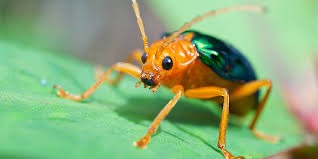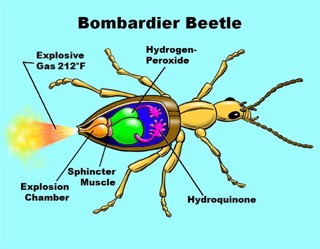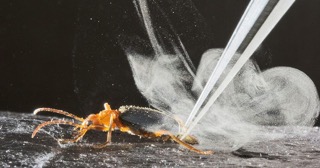Bombardier Beetle
Taxonomy
| Kingdom | Phylum | Class | Order | Family | Subfamily | Genus | |
|---|---|---|---|---|---|---|---|
| Classification | Animalia | Arthropoda | Insecta | Coleoptera | Carabidae | Brachininae | Brachinus |
The Genus Brachinus is home to over 500 different species of Bombardier Beetles. [1]

Body Structure

Bombardier Beetles are small beetles that don't grow over an inch in size. They have redish arms, thorax, and limbs with blue wing coverings. Their body shape and looks are common and not much different from many other beetles, but something their bodies can do is unique [2]. Bombardier Beetles get their name from their special ability or "bomb," which takes inside their abdomen. Insider there, they have two chambers, one containing hydrogen peroxide and one with hydroquinone. When the beetle feels it is being threatened, it excretes some of both, creating a chemical reaction in their reaction chamber.[3] This reaction can be shot out of the beetle's anus like a machine gun shooting rapid bursts of oxygen, quinone, and water. These bursts can be up to 20 MPH and 212 degrees Fahrenheit; it shoots in bursts, allowing for the beetle to cool down. This allows the beetle to fend off prey from consuming it, but when consumed, it is often regurgitated and escapes due to its "bomb". [4]
Habitat and Diet

Bombardier Beetles prefer temperate woodlands and grasslands due to their reliance on hiding under logs and leaf litter. Bombardier beetles are found in North America, South America, Europe, Africa, and Australia [2]. These beetles eat both young insects and detritus, which plays an important role in the decomposition and recycling of nutrients. These beetles rely heavily on their antennae for vibrations as well as eye eyesight and feel to help maneuver and find their food, they usually hunt at night. These beetles prefer moist environments where the soil would have a lot of nutrients on its top layers where these beetles roam.[5]